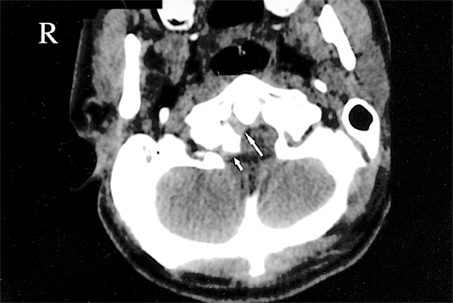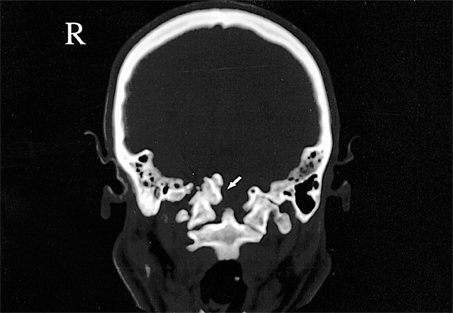Yonsei Med J.
2007 Feb;48(1):120-123. 10.3349/ymj.2007.48.1.120.
Collet-Sicard Syndrome Associated with Occipital Condyle Fracture and Epidural Hematoma
- Affiliations
-
- 1Department of Neurosurgery, Firat University School of Medicine, Elazig, Turkey. fserol@yahoo.com
- 2Department of Radiology, Firat University School of Medicine, Elazig, Turkey.
- KMID: 1093532
- DOI: http://doi.org/10.3349/ymj.2007.48.1.120
Abstract
- A 31-year-old male was presented with a very rare case of ipsilateral palsies of the nerves IX through XII (Collet-Sicard syndrome) after a closed head injury. An occipital condyle fracture that was associated with epidural hematoma was diagnosed by computed tomography. The patient was conservatively managed, and following the treatment, partial neurological recovery ensued. The phenomenon of occipital condyle fracture involving the last four cranial nerve palsies is relatively rare. Although 3 cases of Collet-Sicard syndrome that were caused by an occipital condyle fracture has been reported, the association between condyle fracture and epidural hematoma has never been described before.
Figure
Reference
-
1. Collet FJ. Sur un nouveau syndrome paralytique pharyngolarynge par blessure de guerre (Hemiplegie glosso-laryngo-scapulopharyngee). Lyon Med. 1915. 124:121–129.2. Sicard JA. Syndrome du carrefour condylo-dechire posterieur (type pur de paralysie laryngee associee). Marseille Med. 1917. 53:383.3. Comacchio F, D'Eredita R, Poletto E, Poletti A, Marchiori C. Hemangiopericytoma of the skull base and Collet-Sicard syndrome: a case report. Ear Nose Throat J. 1995. 74:845–847.4. Mohanty SK, Barrios M, Fishbone H, Khatib R. Irreversible injury of cranial nerves 9 trough 12 (Collet-Sicard syndrome). Case report. J Neurosurg. 1973. 38:86–88.5. Anderson PA, Montesano PX. Morphology and treatment of occipital condyle fractures. Spine. 1988. 13:731–736.6. Bolender N, Cromwell LD, Wendling L. Fracture of the occipital condyle. AJR Am J Roentgenol. 1978. 131:729–731.7. Ide C, Nisolle JF, Misson N, Trigaux JP, Gustin T, De Coene B, et al. Unusual occipitoatlantal fracture dissociation with no neurological impairment. Case report. J Neurosurg. 1998. 88:773–776.8. Orbay T, Aykol S, Seckin Z, Ergun R. Late hypoglossal nerve palsy following fracture of the occipital condyle. Surg Neurol. 1989. 31:402–404.9. Hashimoto T, Watanabe O, Takase M, Koniyama J, Kobota M. Collet-Sicard syndrome after minor head trauma. Neurosurgery. 1988. 23:367–370.10. Sharma BS, Mahajan RK, Bhatia S, Khosla VK. Collet-Sicard syndrome after closed head injury. Clin Neurol Neurosurg. 1994. 96:197–198.11. Wani MA, Tandon PN, Banerji AK, Bhatia R. Collet-Sicard syndrome resulting from closed head injury: case report. J Trauma. 1991. 31:1437–1439.12. Connolly B, Turner C, DeVine J, Gerlinger T. Jefferson fracture resulting in Collet-Sicard syndrome. Spine. 2000. 25:395–398.13. Juncos JL, Beal MF. Idiopathic cranial polyneuropathy. A fifteen-year experience. Brain. 1987. 110:197–211.14. Tappin JA, Satchi G, Corless JA, Ashworth F. Multiple myeloma presenting as the Collet-Sicard syndrome. J Neurol Neurosurg Psychiatry. 1996. 60:14.15. Rees JH, Valentine AR, Llewelyn JG. Spontaneous bilateral carotid and vertebral artery dissection presenting as a Collet-Sicard syndrome. Br J Radiol. 1997. 70:856–858.16. Silvestrini M, Floris R, Tagliati M, Stanzione P, Simonetti G. Collet-Sicard syndrome caused by a coiling of the internal carotid artery. Riv Neurol. 1991. 61:135–136.17. Pachner AR, Steere AC. The triad of neurologic manifestations of Lyme disease: meningitis, cranial neuritis, and radiculoneuritis. Neurology. 1985. 35:47–53.18. Bridgman S, McNab W. Traumatic occipital condyle fracture, multiple cranial nerve palsies, and torticollis: a case report and review of the literature. Surg Neurol. 1992. 38:152–156.19. Tuli S, Tator CH, Fehlings MG, Mackay M. Occipital condyle fractures. Neurosurgery. 1997. 41:368–377.20. DiChiro G, Fisher RL, Nelson KB. The jugular foramen. J Neurosurg. 1964. 21:447–460.21. Bucholz RW, Burkhead WZ, Graham W, Petty C. Occult cervical spine injuries in fatal traffic accidents. J Trauma. 1979. 19:768–771.22. Fuentes S, Bouillot P, Dufour H, Grisoli F. Occipital condyle fractures and clivus epidural hematoma. Case report. Neurochirurgie. 2000. 46:563–567.23. Miyazaki C, Katsume M, Yamazaki T, Aoki K, Kuroki T, Takasu N. Unusual occipital condyle fracture with multiple nerve palsies and Wallenberg syndrome. Clin Neurol Neurosurg. 2000. 102:255–258.24. Grundy DJ, McSweeney T, Jones HW. Cranial nerve palsies in cervical injuries. Spine. 1984. 9:339–343.
- Full Text Links
- Actions
-
Cited
- CITED
-
- Close
- Share
- Similar articles
-
- Management of a traumatic avulsion fracture of the occipital condyle in polytrauma patient in Korea: a case report
- Collet-Sicard Syndrome with Dysphagia due to Cerebellopontine Angle Meningioma : A case report
- Collet-Sicard Syndrome in a Patient with Jefferson Fracture
- A Case of Collet-Sicard Syndrome Resulting from Jugular Vein Thrombosis
- Collet-Sicard Syndrome With Hypoglossal Nerve Schwannoma: A Case Report



